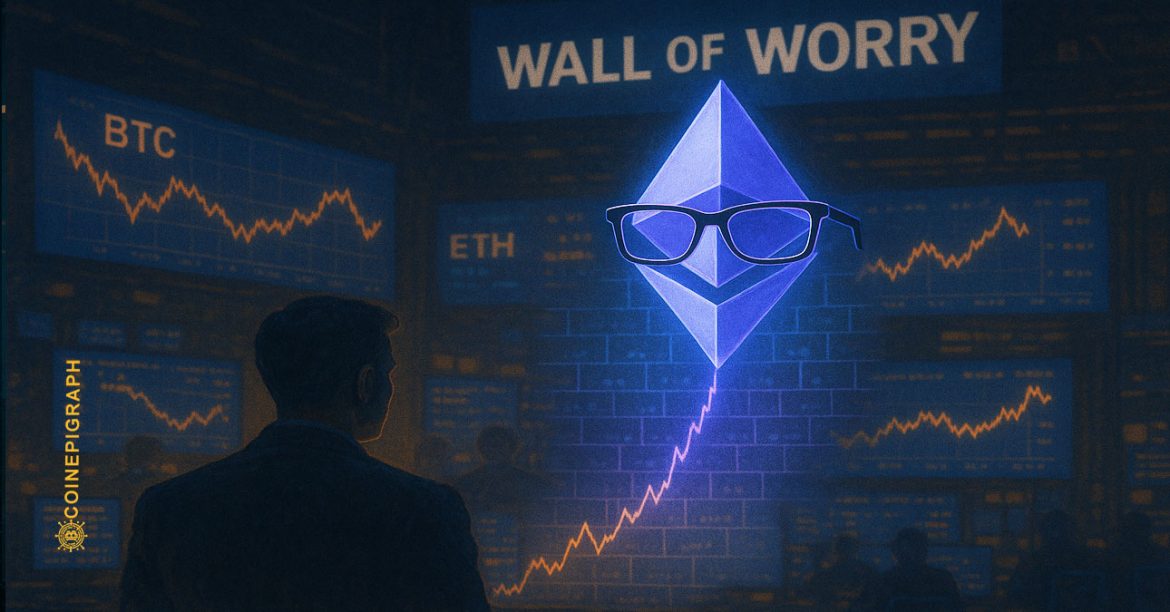By CoinEpigraph Editorial Desk | November 5, 2025
A Familiar Climb
Every bull market, says the adage, “climbs a wall of worry.”
This week, Fundstrat’s Tom Lee returned to CNBC to remind investors that anxiety itself is not a sign of failure — it’s the fuel for future rallies. Speaking on the network’s Market Update segment, Lee described an environment heavy with uncertainty yet loaded with latent upside. His message: markets, including crypto, are far from euphoric; they’re still wrestling with disbelief.
“Everyone’s afraid of the next shoe dropping,” Lee observed, pointing to geopolitical friction, rate-cut confusion, and algorithmic volatility in digital assets. “But walls of worry are what bull markets climb. If investors waited for clarity, they’d miss the recovery.”
Uncertainty as Capital
Lee’s remarks arrive at a moment when crypto’s mood swings more violently than its price chart. Institutional traders remain cautious; retail flows have faded; yet on-chain activity and developer commitments remain resilient. The contradiction is classic late-cycle psychology — fear mixed with fatigue.
Lee argues that this ambient anxiety can paradoxically create a kind of uncertainty dividend: as long as investors distrust the rally, there’s capital still waiting on the sidelines. “Markets rarely collapse when everyone expects disaster,” he said, echoing a sentiment he’s voiced since 2018. “They collapse when optimism is unanimous.”
For CoinEpigraph readers, that notion intersects neatly with crypto’s behavioral dynamics. Web3 ecosystems thrive on asymmetric belief — conviction among the few before recognition by the many. In that sense, the “wall of worry” becomes not a warning, but a moat.
Reading Between the Macro Lines
Fundamentally, Lee maintains his call for disinflation and earnings stabilization into the next quarter, which he believes will eventually lift risk assets — crypto included. But his deeper observation targets psychology, not policy: markets function as information systems, and right now those systems are overloaded with noise.
Interest-rate narratives shift weekly. AI stocks dominate mind-share while blockchain infrastructure consolidates quietly. Bond yields spook equities; then they retreat, prompting algorithmic reversals. Lee’s position is that beneath these oscillations lies an enduring liquidity cycle — and liquidity, not sentiment, drives sustainable recoveries.
Still, the volatility in digital assets tells a parallel story: an industry searching for its new risk premium. Bitcoin trades like digital gold one week and a tech stock the next; Ethereum vacillates between protocol and platform. The constant recalibration feeds a perception of chaos, which in Lee’s framework, is exactly the condition that precedes re-accumulation.
Doubling Down on Ethereum
Lee’s conviction isn’t theoretical. According to recent fund disclosures and commentary close to Fundstrat’s crypto desk, he has quietly increased Ethereum exposure throughout the downturn.
In his own words: “You don’t buy faith at the top — you buy it when belief is cheap.”
While the broader market rotates defensively, Lee appears to be positioning for Ethereum’s next structural leg — not as a speculative rebound, but as a utility thesis: a network at the center of tokenized assets, staking yield, and on-chain AI computation.
That move underscores the very logic of the “wall of worry.” When confidence collapses, capital migrates toward assets with structural optionality — blockchains capable of earning yield, supporting real-world assets, and interoperating with AI layers. Ethereum fits that bill more than any other platform in Lee’s current models.
His timing may appear audacious, but historically, Lee’s most controversial entries have proven the most prescient. In 2018, he defended Bitcoin near its $3,000 low; in 2020, he forecast a recovery amid record pessimism. His renewed accumulation of ETH signals he sees this bear market as a building phase, not a burial.
Crypto’s Contrarian Signal
Lee’s long-running thesis has been that crypto bottoms are forged in silence, not hype. His CNBC appearance reiterated that view indirectly: low sentiment, fragmented participation, and over-hedged portfolios tend to mark turning points.
He also hinted that AI enthusiasm may be masking crypto’s next inflection. “AI and blockchain are not rivals,” he said. “They’re complementary systems in a digitizing economy.” The comment matters — it bridges two megatrends often portrayed as competitors for capital. In Lee’s logic, as AI becomes centralized within corporate superclusters, crypto remains the decentralizing counterweight. The “wall of worry” for one may be the “path of proof” for the other.
That synthesis — AI as power concentration, crypto as power distribution — echoes the same structural lens that David Sacks described in his recent “Orwellian vs Terminator” framing of AI threats. Both men, in different language, are pointing to a future where control architectures determine market resilience more than pure economics.
The Market as Maze
Investors today are navigating more than valuation; they’re moving through a data maze of policy leaks, algorithmic trading triggers, and emotional reflexes amplified by social feeds. Lee’s metaphorical wall could just as well be the maze of modern finance — opaque, shifting, and occasionally self-defeating.
Yet his counsel remains consistent: hold through discomfort, seek asymmetry, distrust consensus. Historically, his optimism has not been blind. In 2020 he called for a recovery when panic was universal; in mid-2022 he warned that despair would create once-in-a-cycle entry points. His current tone is subdued but similar — a signal that pessimism may again be mispriced.
Beyond the Fear Curve
Markets do not reward comfort; they reward calibration. The same is true for decentralized economies that oscillate between euphoria and extinction headlines. Lee’s interview doesn’t guarantee a bottom — but it reminds investors that uncertainty is not absence of opportunity.
If the wall of worry remains high, crypto may be one of the few sectors still agile enough to climb it.
At Coinepigraph, we pride ourselves on delivering cryptocurrency news with the utmost journalistic integrity and professionalism. Our dedicated team is committed to providing accurate, insightful, and unbiased reporting to keep you informed in the ever-evolving crypto landscape. Stay tuned as we expand our coverage to include new sections and thought-provoking op-eds, ensuring Coinepigraph remains your trusted source for all things crypto. -Ian Mayzberg Editor-in-Chief
The team at CoinEpigraph.com is committed to independent analysis and a clear view of the evolving digital asset order.
To help sustain our work and editorial independence, we would appreciate your support of any amount of the tokens listed below. Support independent journalism:
BTC: 3NM7AAdxxaJ7jUhZ2nyfgcheWkrquvCzRm
SOL: HxeMhsyDvdv9dqEoBPpFtR46iVfbjrAicBDDjtEvJp7n
ETH: 0x3ab8bdce82439a73ca808a160ef94623275b5c0a
XRP: rLHzPsX6oXkzU2qL12kHCH8G8cnZv1rBJh TAG – 1068637374
SUI – 0xb21b61330caaa90dedc68b866c48abbf5c61b84644c45beea6a424b54f162d0c
and through our Support Page.
🔍 Disclaimer: CoinEpigraph is for entertainment and information, not investment advice. Markets are volatile — always conduct your own research.
COINEPIGRAPH does not offer investment advice. Always conduct thorough research before making any market decisions regarding cryptocurrency or other asset classes. Past performance is not a reliable indicator of future outcomes. All rights reserved ™ © 2024-2025.





